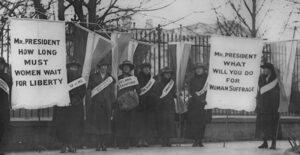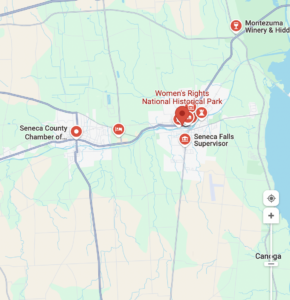Nunes
full exhibit draft

Citation
Evans, Sara M. “The Politics of Liberal Feminism.” Social Science Quarterly (University of Texas Press), vol. 64, no. 4, Dec. 1983, pp. 882–86. EBSCOhost, search.ebscohost.com/login.aspx?direct=true&db=a9h&AN=16670445&site=ehost-live.
Lange, Allison K.. "White Public Mothers and Militant Suffragists Win the Vote." In Picturing Political Power: Images in the Women's Suffrage Movement University of Chicago Press, 2020. Chicago Scholarship Online, 2021. (159-210) https://doi.org/10.7208/chicago/9780226703381.003.0007.
Songstad, Nicole. “Speech-Giving and the Woman Suffrage Movement: Exploring Government Databases for Women’s Voices.” DttP: A Quarterly Journal of Government Information Practice & Perspective, vol. 51, no. 3, Fall 2023, pp. 30–35. EBSCOhost, https://doi.org/10.5860/dttp.v51i3.8127.
Spurlock, John C. “A Masculine View of Women’s Freedom: Free Love in the Nineteenth Century.” International Social Science Review, vol. 69, no. 3/4, June 1994, p. 34. EBSCOhost, search.ebscohost.com/login.aspx?direct=true&db=a9h&AN=9502214862&site=ehost-live
- https://www.saturdayeveningpost.com/2017/03/womans-rebellion-story-suffrage-1909/ Bortel, "The Woman's Rebellion: A Story of Suffrage in 1909," ]
Women's Rights Movement - 1900s
Seneca Falls Convention, Seneca Falls, NY - 1900
In the 1900s, the women's rights movement had marked a huge transformative period in history all over the world. Women from all over the globe came together to bring down the political, economic, and societal issues that had them in the position they were in. The United States had seen a huge and impactful change toward gender equality. Women were not just fighting for voting rights, but for fair wages, better representation in politics, challenging gender norms, and paving the way for feminism within the United States and even around the world. The fight for equality for women intensified everyday in the United States during the 1900s, and continues to do so to this day.
Historiography
The history of the women’s rights movement is the kind of history that will never be forgotten about. Many people have written and told the stories of the struggles women have faced and how they have overcome these struggles without losing hope. Some of the authors on the subject of the women's rights movement include Nicole Songstad, Allison K. Lange, John C. Spurlock, and Sara M. Evans. Sara M. Evans’ article, “The Politics of Liberal Feminism” takes the time to explain and examine the way liberal feminism in the United States has evolved. Within her article, Evans argues how as a response to systemic inequalities in places such as politics, education, and employment has caused liberal feminism to grow and emerge. Evans also brings to light how feminists would prioritize issues like discrimination in the workplace, equal access for all for education, reproductive rights, and more. Though there was a lot of support for the women's rights movement, Evans also took time to highlight the struggles and criticisms that the movement had faced from others including radical feminists. In her paper, Evans explains liberal feminism to be both an influential and dynamic force that made great changes and influences toward equal rights for women. Allison K. Lange is an expert on the history of Women's Suffrage in the United States. While being an expert, Lange is also a professor, speaker, and curator to the public. Lange, who is a historian, explains and explores the history and stories that come from the pictures that tell a story about the intersection of gender and power within the United States. In her book, “Picturing Political Power: Images in the Women's Suffrage Movement”, readers can both understand and see how women lived through the stories in the pictures. Chapter six, “White Public Mothers and Militant Suffragists Win the Vote”, of Lange's book focuses on the idealized femininity that has been embraced by white and black women. In the 1900s, came new technologies that suffragists would take advantage of. Lange finds photographs from the time of the Women's Suffrage and finds the story within the photographs. Since suffragists found the new technology of that time, photographs were able to be printed within the newspapers of the towns. These photographs captured many stories of the protests and day to day lives of those a part of the Women's Suffrage. Lange examines, understands, and describes the roles that the photography played in shaping the end phases of the women's suffrage movement. In this chapter, chapter six, Lange talks about how women, more specifically white women, and how they got to be where they are. In this chapter readers learn about how suffragists made their campaign by drawing attention to their maternal roles. By doing this, women suffragists made the point of how they are the "public's mothers." This chapter also shows and talks about how militant tactics were used in other women's suffrage groups like The National Women's Party. The National Women's Party used and took more confrontational photographs in the hopes of challenging the perception of female political engagement. Nicole Songstad’s article, “Speech-Giving and the Woman Suffrage Movement: Exploring Government Databases for Women's Voices”, analyzes how the stories and speeches told, contributed and played a role in the United States for the fight for women's rights. In her article, Songstad takes the time to emphasize the value of government databases and the importance of the rhetorical strategies that were used by the suffragists during that time. Suffragists like Susan B. Anthony and others are mentioned within this article to show how they turned their speech making into a powerful tool that impacted the women's rights movement and the level of equality. Overall, Songstad takes the time to explain how much public speaking during the women's rights movement had impacted where women are today. John C. Spurlock’s article focuses and highlights the free love movement of the 19th century. He also explores the implications for women's autonomy and their societal roles. Spurlock brings up in his article how men of the free love movement tried to really understand women’s freedom, but it still sometimes would seem that they were focusing on male dominance rather than gender equality for women. This article by Spurlock is a good analysis of how the gender dynamics ended up shaping the free love movement. This happened by highlighting both its potential and the limitations that were faced while having deep conversations about women's rights.The Movement and the Problems Faced
The women's rights movement of the 1900s was an important era of activism that focused on gaining equality for women in all different aspects of everyday life. Throughout the movement, there were many great achievements that movement and women gained. In 1920 women were now able to vote in the United States. Along with many other great achievements, this allowed for women to feel more accepted around the United States but also around the world in other countries. Movements like the women's rights movement had encouraged other women from other countries to start fighting for more equality like voting rights, the right to an education, equal pay in the workplace, and more. Though there were many great achievements, there were also a lot of struggles and challenges that were faced during this movement. There happened to be a lot of resistance with the women's rights movement that came from conservative groups and more traditional groups. These groups believed that women’s roles should stay how they are and that there should be no change in equality. Even though this women's rights movement focused on equal rights for women, it would tend to leave out women of color, working class women, and immigrant women pushed to the back. This then made them work with themselves to create movements that were for all women. During the women's movements to fight for equality, they were still faced with economic, political, and societal hardships. Women were still struggling with unequal pay, limited opportunities when it came to work, and poor working conditions along with a load of hate from people all over the world. Even though they were dealing with these struggles and hate, the women never gave up. The hate they faced would soon turn into acceptance and hope due to the women's rights movement laying down a foundation for equal rights for women and for the future women and their continuous fight for equal rights around the world. [footnote]Allison K. Lange. Picturing Political Power: Images in the Women’s Suffrage Movement. The University of Chicago Press, 2020. https://search-ebscohost-com.proxy.ulib.csuohio.edu/login.aspx?direct=true&db=edspfc&AN=edspfc.1851492&site=eds-live&scope=site. ↵
